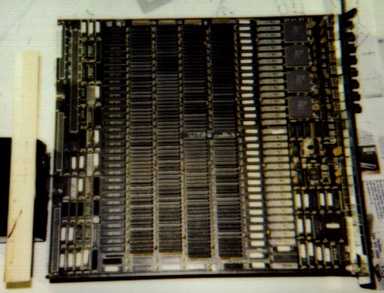 The TAAC is a large (even by VME bus standards) double-plane board that fills 3 slots in a "deskside" chassis Sun. I realise the photo is a bit blurry, but off to the left is a 1 foot wooden ruler, making the card about a 15 inch square, and it weighs about 12 pounds. There are eight BNC type connectors (visible in the upper right of the photo), 4 for video in and 4 for video out (RGB+Sync). A large amount of RAM chips and some large square chips (I assume they are processors) populate the board. As the board is really two boards stacked one on-top of the other, I wasn't able to get a very clear look at the lower board.
The TAAC is a large (even by VME bus standards) double-plane board that fills 3 slots in a "deskside" chassis Sun. I realise the photo is a bit blurry, but off to the left is a 1 foot wooden ruler, making the card about a 15 inch square, and it weighs about 12 pounds. There are eight BNC type connectors (visible in the upper right of the photo), 4 for video in and 4 for video out (RGB+Sync). A large amount of RAM chips and some large square chips (I assume they are processors) populate the board. As the board is really two boards stacked one on-top of the other, I wasn't able to get a very clear look at the lower board.
I was naturally curious as to what the board did. Despite it's name, my Sun 3/160 didn't seem to run any faster regardless of whether the board was in it or not, and I couldn't get video out of it simply by connecting a monitor. Thus, I tried to figure out how I could access the card, since it seemed to have it's own ram and processors. It looked like a "computer within a computer", and I started my search for information.
A web-search was mostly fruitless - I have posted that info via this link - so, instead, tried to find those responsible for the creation of the TAAC-1.
The TAAC could drive a separate monitor but normally it was hooked up to provide a full color window on the regular monitor. You did this by running a cable from the standard Sun RGB output into the TAAC, then hooking the TAAC to your monitor. The TAAC had a "chroma-key" circuit so that when it saw a window of a particular color coming from the standard board, it would replace that window with TAAC-generated video. Why do this ? When we developed the TAAC we were a really small company and didn't want to port the whole windows system onto the TAAC. Using the chroma-key, we could automagically become a window. Later, when we were bought by Sun, we could have ported the window system I guess but it made more sense to concentrate the TAAC on other tasks, like graphics, imaging, volume visualization, etc.
The TAAC stands for Trancept Application ACcelerator. It was designed for accelerating scientific visualization tasks which needed high performance (at the time) graphics integrated with computational tasks. Other than a few demos which may have come with it it didn't do anything unless you programmed it. Most programs consisted of two parts. The host portion which usually contained the bulk of the program, and the TAAC part which contained accelerated versions of certain key algorithms. Libraries were provided for doing communication between the Sun and the TAAC. There was a C compiler, an assembler, and some libraries for doing certain common tasks. If the Sun has a color frame buffer, the TAAC-1 shares that monitor. The output of the color frame buffer is connected to the input of the TAAC-1 which then goes to the monitor. The TAAC would insert it's video wherever a particular color was being displayed. Unless you are seriously interested in programming ancient hardware just for the experience I would recommend that you not bother getting into it. The cheapest PC's available today are much faster than anything you can do with the TAAC. It has 200 bit instructions but the clock is only 8Mhz so even after considering that it can do 2 ALU ops, 2 float ops, a barrel shift, a table lookup, and a memory I/O operation every cycle it would only be the equivelent of a 56Mhz machine under the best circumstances and since it isn't a general purpose machines the "best circumstances" are pretty rare.